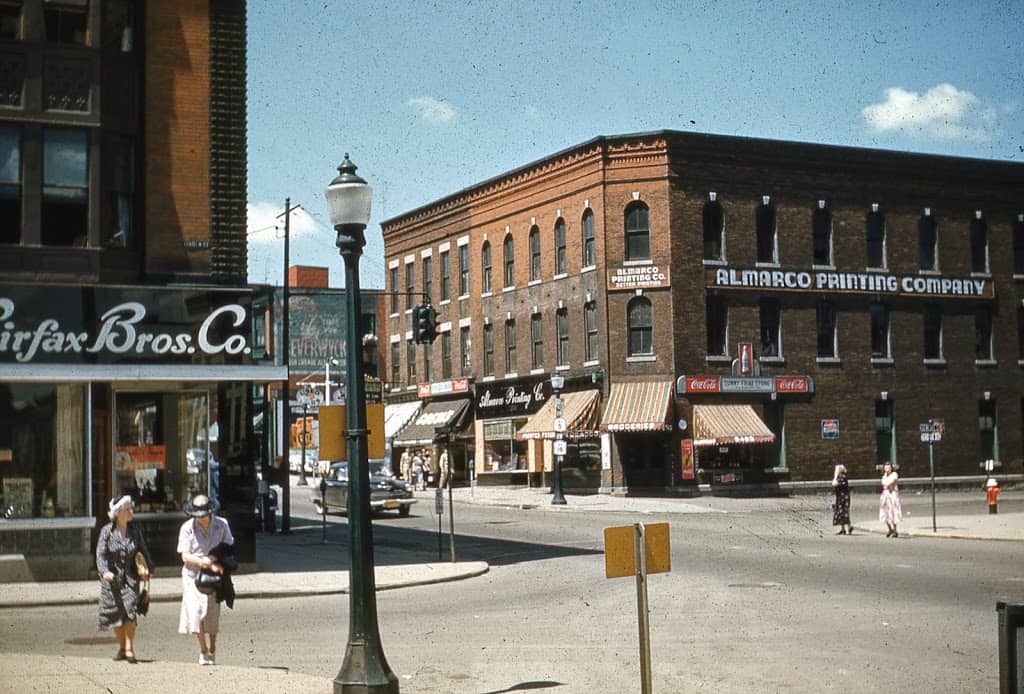Geneva Downtown Commercial Historic District
By John Marks, Curator of Collections and Exhibits
About 18 months ago I wrote about the details of national, state, and local historic preservation programs. They bear revisiting in the wake of the National Register of Historic Places approving the Geneva Downtown Commercial Historic District.
The district includes most of traditional downtown, the rectangle formed by Seneca, Exchange, Castle, and Main Streets. Linden Street is included, as are the Exchange Street buildings just north of Castle Street and just south of Seneca Street. The three late-1960s bank buildings on Exchange Street and the Rite Aid drugstore on the corner of Castle and Main Streets are excluded from the district.
 |
| Several downtown buildings, such as this bank on Linden Street and the Smith Opera House on Seneca Street, are already on the National Register. |
More websites and newspaper articles, including the Finger Lakes Times, are doing a good job dispelling myths about preservation designations. A National Register listing doesn’t restrict the owner; in fact, properties can’t be listed without the owner’s consent. As long as no federal government money is involved, a Nation Register property owner can demolish their property if they wishes. (Local preservation ordinances, zoning, and demolition permits are another story.)
A National Register listing doesn’t come with free money to preserve the building. Owners of income-producing properties are eligible for a 20% federal income tax credit, with numerous qualifications. Any preservation work, inside or out, must meet the Secretary of the Interior’s Standards for Rehabilitation and be approved by the National Park Service. The Standards require methods and materials which, while in the best interests of preservation, may be more expensive. Then, the cost of approved work must exceed the “adjusted basis value” – building value minus land value equals the adjusted value. Finally, you may claim 20% of approved costs…on the next income tax you file.
As my dad says, this beats a poke in the eye with a sharp stick, but its complicated money. It’s not cash-in-hand as work is being done. It requires extensive paperwork and approval by preservation representatives. Depending on the adjusted value of your property, the credit may only work for large scale, whole-building projects; it probably would not apply to simply restoring windows and doors to their original appearance.
New York State offers an additional 20% credit on projects that are receiving federal credit…if the building is in an “eligible census tract” and certain fees are paid. If you read in an article that up to 40% income tax credit may be available for preservation, this is what it means.
 |
| The Fairfax, Almarco, and Oddfellows Buildings are all under consideration for rehabilitation. |
So why does the National Register listing matter if there are financial hoops and paperwork? It matters for large-investment projects, of which there are several on the drawing board for downtown. Property owners were invited to a 2013 meeting and had the chance to hear about and question all aspects of a district listing. They supported the nomination, either in hopes of using tax credits themselves, or to help preservation work downtown by other owners.
The National Register still matters as a brand. We now have three districts and maybe two handfuls of individual properties on the Register. You can preserve old buildings without recognition, but it immediately means something to visitors (tourists, college families, prospective Genevans) who care. For as much as we’ve lost, Geneva is still seen as a city that has preserved a lot of its architecture.
National Register of Historic Places nominations, as well income tax credit programs, are handled through the New York State Historic Preservation Office. To learn more, go to http://nysparks.com/shpo
